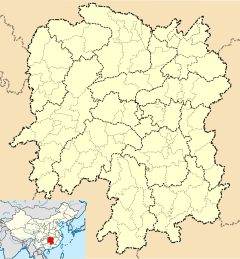Wan Pavilion
Appearance
| Wan Pavilion | |
|---|---|
万楼 | |
| General information | |
| Type | Chinese pavilion |
| Country | China |
| Coordinates | 27°52′40″N 112°57′15″E / 27.877846°N 112.95421°E |
| Groundbreaking | 1615 |
| Renovated | 2017 |
| Affiliation | Xiangtan municipal government |
| Height | |
| Architectural | Chinese architecture |
| Technical details | |
| Material | Wood, brick, cement |
Wan Pavilion (simplified Chinese: 万楼; traditional Chinese: 萬樓; pinyin: Wàn Lóu) is a Chinese pavilion located in Yuhu District of Changsha, Hunan, China.
History
[edit]Wan Pavilion was originally built in 1615 by magistrate Bao Hongkui (包鸿逵) and named by Li Tengfang, a senior politician in the Ming dynasty (1368–1644),[1] but because of war and natural disasters has been rebuilt numerous times since then. The present version was completed in 2017.[2]
Architecture
[edit]The total height of Wan Pavilion is 63.48-metre (208.3 ft), and the main building is 52.58-metre (172.5 ft). It has nine floors inside and five floors outside, which means "jiuwu zhizun (the imperial throne)" (九五之尊).
Gallery
[edit]References
[edit]- ^ Ou Qiduan (欧启瑞); Tian Xinyu (田新宇); Fu Yajie (符雅洁) (2017-04-15). 湘潭万楼:重建的“湘江第一楼”. Sohu. Retrieved 2021-11-26.
- ^ Liu Ju (刘炬) (2008-09-23). 湘潭重建万楼再现明代风采. sina. Retrieved 2021-11-26.








